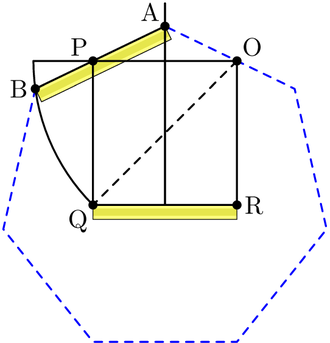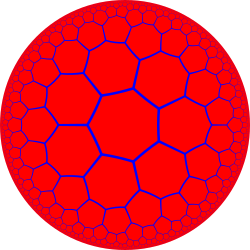Heptagon
| Regular heptagon | |
|---|---|
| Dual polygon | Self |
In geometry, a heptagon or septagon is a seven-sided polygon or 7-gon.
The heptagon is sometimes referred to as the septagon, using
Regular heptagon
A is {7}.
Area
The area (A) of a regular heptagon of side length a is given by:
This can be seen by subdividing the unit-sided heptagon into seven triangular "pie slices" with
The area of a regular heptagon
Construction
As 7 is a
 A neusis construction of the interior angle in a regular heptagon. |
 An animation from a neusis construction with radius of circumcircle , according to Andrew M. Gleason[1] based on the angle trisection by means of the tomahawk. This construction relies on the fact that
|

An animation from a neusis construction with marked ruler, according to David Johnson Leisk (Crockett Johnson).
Approximation
An approximation for practical use with an error of about 0.2% is to use half the side of an equilateral triangle inscribed in the same circle as the length of the side of a regular heptagon. It is unknown who first found this approximation, but it was mentioned by
This approximation uses for the side of the heptagon inscribed in the unit circle while the exact value is .
Example to illustrate the error:
At a circumscribed circle radius r = 1 m, the absolute error of the 1st side would be approximately -1.7 mm
Other approximations
There are other approximations of a heptagon using compass and straightedge, but they are time consuming to draw. [4]
Symmetry

The regular heptagon belongs to the
Diagonals and heptagonal triangle

The regular heptagon's side a, shorter diagonal b, and longer diagonal c, with a<b<c, satisfy[7]: Lemma 1
- (the optic equation)
and hence
and[7]: Coro. 2
Thus –b/c, c/a, and a/b all satisfy the cubic equation However, no algebraic expressions with purely real terms exist for the solutions of this equation, because it is an example of casus irreducibilis.
The approximate lengths of the diagonals in terms of the side of the regular heptagon are given by
We also have[8]
and
A heptagonal triangle has vertices coinciding with the first, second, and fourth vertices of a regular heptagon (from an arbitrary starting vertex) and angles and Thus its sides coincide with one side and two particular diagonals of the regular heptagon.[7]
In polyhedra
Apart from the heptagonal prism and heptagonal antiprism, no convex polyhedron made entirely out of regular polygons contains a heptagon as a face.
Star heptagons
Two kinds of star heptagons (heptagrams) can be constructed from regular heptagons, labeled by Schläfli symbols {7/2}, and {7/3}, with the divisor being the interval of connection.

Blue, {7/2} and green {7/3} star heptagons inside a red heptagon.
Tiling and packing
A regular triangle, heptagon, and 42-gon can completely fill a plane vertex. However, there is no tiling of the plane with only these polygons, because there is no way to fit one of them onto the third side of the triangle without leaving a gap or creating an overlap. In the hyperbolic plane, tilings by regular heptagons are possible. There are also concave heptagon tilings possible in the Euclidean plane.[9]

The regular heptagon has a double lattice packing of the Euclidean plane of packing density approximately 0.89269. This has been conjectured to be the lowest density possible for the optimal double lattice packing density of any convex set, and more generally for the optimal packing density of any convex set.[10]
Empirical examples
The 1000
Many states use a Reuleaux heptagon, a curve of constant width, for some of their coins; the sides are curved outwards to allow the coins to roll smoothly when they are inserted into a vending machine. These include:
- United Kingdom fifty pence and twenty pence (and corresponding coins in Jersey, Guernsey, Isle of Man, Gibraltar, Falkland Islands and Saint Helena)
- Barbadian Dollar
- Botswana pula (2 Pula, 1 Pula, 50 Thebe and 5 Thebe
- Mauritius
- U.A.E.
- Tanzania
- Samoa
- Papua New Guinea
- São Tomé and Príncipe
- Haiti
- Jamaica
- Liberia
- Ghana
- the Gambia
- Jordan
- Guyana
- Solomon Islands
The
A number of coins, including the 20 euro cent coin, have heptagonal symmetry in a shape called the Spanish flower.
In architecture, heptagonal floor plans are very rare. A remarkable example is the Mausoleum of Prince Ernst in Stadthagen, Germany.
Many police badges in the US have a {7/2} heptagram outline.
See also
References
- JSTOR 2323624. Archived from the original(PDF) on 19 December 2015.
- .
- ^ G.H. Hughes, "The Polygons of Albrecht Dürer-1525, The Regular Heptagon", Fig. 11 the side of the Heptagon (7) Fig. 15, image on the left side, retrieved on 4 December 2015
- ^ raumannkidwai. "Heptagon." Chart. Geogebra. Accessed January 20, 2024. https://www.geogebra.org/classic/CvsudDWr.
- ISBN 978-1-56881-220-5(Chapter 20, Generalized Schaefli symbols, Types of symmetry of a polygon pp. 275-278)
- ISBN 0-521-08139-4.
- ^ a b c Abdilkadir Altintas, "Some Collinearities in the Heptagonal Triangle", Forum Geometricorum 16, 2016, 249–256.http://forumgeom.fau.edu/FG2016volume16/FG201630.pdf
- ^ Leon Bankoff and Jack Garfunkel, "The heptagonal triangle", Mathematics Magazine 46 (1), January 1973, 7–19.
- ^ Sycamore916, ed. "Heptagon." Polytope Wiki. Last modified November 2023. Accessed January 20, 2024. https://polytope.miraheze.org/wiki/Heptagon.
- MR 3318753.
External links
- Definition and properties of a heptagon With interactive animation
- Heptagon according Johnson
- Another approximate construction method
- Polygons – Heptagons
- Recently discovered and highly accurate approximation for the construction of a regular heptagon.
- Heptagon, an approximating construction as an animation
- A heptagon with a given side, an approximating construction as an animation
Heptagon






























